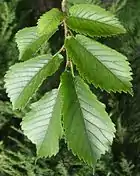Ulmus × hollandica 'Groeneveld'
The Dutch hybrid elm cultivar Ulmus × hollandica 'Groeneveld' was cloned in 1949 at the De Dorschkamp Institute, Wageningen, and released in 1963 in response to the earlier, less virulent form of Dutch elm disease that afflicted Europe shortly after the First World War.[1][2] The cultivar was derived from a crossing of Dutch clones '49',[3] (originally believed to be an English Wych Elm Ulmus glabra but later identified as another example of Ulmus × hollandica) and '1', a Field Elm Ulmus minor found in central France and marketed by the Barbier nursery in Orléans.[4]
| Ulmus × hollandica 'Groeneveld' | |
|---|---|
 'Groeneveld'
Stanmer Park, Brighton, UK | |
| Hybrid parentage | U. × hollandica × U. minor |
| Cultivar | 'Groeneveld' |
| Origin | Netherlands |
Description

The tree is slow growing, and produces a dense, upswept growth which initially made it popular as a street tree in the Netherlands.[5] The dark-green obovate leaves are < 9 cm long by 4 cm broad, arranged in clusters on short branchlets.[6][7]
Pests and diseases
'Groeneveld' has good resistance to Coral-spot fungus Nectria cinnabarina, and Black Spot . However, like all the other Dutch hybrids released before 1989, it proved to have only marginal resistance, rated 3 out of 5 [8] to the later, virulent form of Dutch elm disease and consequently planting is no longer recommended where the disease is prevalent.[4][9]
Cultivation
'Groeneveld' was also introduced elsewhere in Europe, including Britain, in small numbers. The tree was briefly propagated and marketed in the UK by the Hillier & Sons nursery, Winchester, Hampshire from 1975 to 1977, during which time 29 were sold.[10][11]The tree was planted in trials in Canberra, Australia started in 1988, but has not shown promise in that environment so far; it has however proved popular in New Zealand. There are several specimens in American arboreta (see under Accessions).
Notable trees
The TROBI Champion tree in the UK is at Stanmer Park, near Brighton, East Sussex, measuring 18 m high by 53 cm d.b.h. in 2002[12]
Etymology
'Groeneveld' translates as 'green field', and was named for the eponymous de Dorschkamp trial site at Wageningen.
Hybrid cultivars
- FL 522: derived from a crossing with the Chinese species Ulmus chenmoui by the Istituto per la Protezione delle Piante in Florence; it has not been released to commerce.
Accessions
North America
- Holden Arboretum, US. Acc. no. 70–127
- Morton Arboretum, US. Acc. no. 76–72, 29–2007 (graft).
Europe
- Brighton & Hove City Council, UK. NCCPG Elm Collection , UK champion: Stanmer Park, 18 m high, 53 cm d.b.h. in 2002.[13]
- Grange Farm Arboretum , Sutton St. James, Spalding, Lincs., UK. Acc. no. 830.
- Royal Botanic Garden Wakehurst Place, UK. Acc. no. 1975–6125
- Sir Harold Hillier Gardens, Romsey, UK. Acc. no. 1977.6442
- Wijdemeren City Council Netherlands. Elm Arboretum; Zuidsingel circa 1985 and Strandje Wijde Blik 2019 Kortenhoef; ‘s-Gravelandsevaartweg, Loosdrecht: ten trees planted 2018. 9 trees planted 2018 Nedervecht, Nederhorst den Berg.
Nurseries
Europe
- Bellwood Trees, Meigle, Perthshire, Scotland, UK.
- De Reebock , Zwalm, Belgium.
- Noordplant , Glimmen, Netherlands.
- Westerveld Boomkwekerij , Opheusden, Netherlands.
References
- Burdekin, D.A.; Rushforth, K.D. (November 1996). Revised by J.F. Webber. "Elms resistant to Dutch elm disease" (PDF). Arboriculture Research Note. 2/96: 1–9. ISSN 1362-5128. Retrieved 26 October 2017.
- Santamour, Frank S.; Bentz, Susan E. (May 1995). "Updated Checklist of Elm (Ulmus) Cultivars for use in North America". Journal of Arboriculture. 21 (3): 122–131. Retrieved 20 June 2016.
- Trial elm 'Clone 49', WAG.1846749 bioportal.naturalis.nl
- Heybroek, H.M. (15 March 1964). Translated by Holmes, F.W. "De iep 'Groeneveld'" [The Groeneveld elm]. The Plant Disease Reporter. 48 (3): 187–189. Retrieved 26 October 2017.
- White, J. & More, D. (2002). Trees of Britain & Northern Europe. Cassell's, London.
- noordplant.nl, 'Groeneveld' leaves, Amsterdam
- Photographs of 'Groeneveld' elm and samarae
- Heybroek, H. M., Goudzwaard, L, Kaljee, H. (2009). Iep of olm, karakterboom van de Lage Landen (:Elm, a tree with character of the Low Countries). KNNV, Uitgeverij. ISBN 9789050112819
- Heybroek, H.M. (1993). "The Dutch Elm Breeding Program". In Sticklen, Mariam B.; Sherald, James L. (eds.). Dutch Elm Disease Research. New York, USA: Springer-Verlag. pp. 16–25. ISBN 978-1-4615-6874-2. Retrieved 26 October 2017.
- Hillier & Sons (1977). Catalogue of Trees & Shrubs. Hillier, Ampfield, UK.
- Hillier & Sons Sales inventory 1962 to 1977 (unpublished).
- Johnson, O. (2011). Champion Trees of Britain & Ireland, 169. Kew Publishing, Kew, London. ISBN 9781842464526.
- Johnson, O. (2003). Champion Trees of Britain & Ireland. Whittet Press, ISBN 9781873580615
External links
- "Herbarium specimen - WAG.1846627". Botany catalogues. Naturalis Biodiversity Center. Sheet labelled 'Baarn, trial elm no.296', 1962 = 'Groeneveld' (Heybroek)
- "Herbarium specimen - WAG.1846630". Botany catalogues. Naturalis Biodiversity Center. Samarae specimen. Sheet labelled 'Baarn, trial elm no.296', 1962
